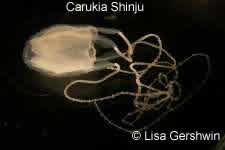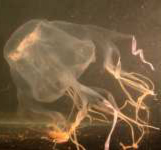Stinger Overview
There are many types of jellyfish, most of which are harmless to humans. Some jellyfish cause slight skin irritation and pain that generally subsides after about 15-30 minutes.
There are two types of tropical marine jellyfish that can cause serious injury; these are the Irukandji and Box Jellyfish.
Irukandji Jellyfish

Irukandji syndrome is the name used to describe a particular set of symptoms displayed following a marine sting. The Irukandji is a group of tiny box-shaped jellyfish that has a diameter of around 1-2 cm. It has four thin tentacles (one in each corner) and the body is transparent and usually very difficult to see in the water.
There are currently ten types of Irukandji jellyfish found around the world. In Broome two species has been identified. Carukia shinju and Malo maxima. It is interesting to note that many Irukandji species have stinging cells all over their body. People can therefore be stung without touching the tentacles of the jellyfish. Irukandji are rare, but stings can be life threatening.
The initial sting from an Irukandji is quite mild, feeling like sea lice or a mosquito bite. There is often no mark, or perhaps small, red "goose pimple" marks. Often the Irukandji sting site will sweat profusely. Around 20 - 30 minutes following the sting the person will begin to display symptoms that can include severe lower back pain, shooting muscle pain, difficulty breathing, nausea, vomiting and headaches. The person may also feel anxious or restless.
Box Jellyfish

This large jellyfish measures up to 30cm long and has up to 15 ribbon-like tentacles from each of the four corners (total of 60 tentacles).
Although the box jellyfish is large, it is transparent and almost impossible to see in the water.
The Box Jellyfish causes a severe whip-like, burning red laceration marks to the skin. Severe stings may cause the victim to stop breathing or their heart to stop beating.